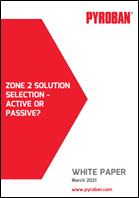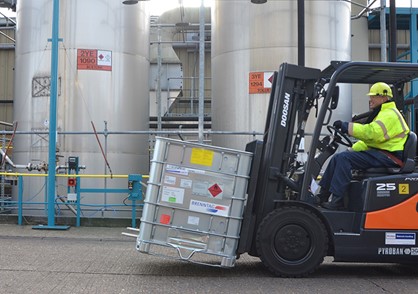When specifying a forklift truck (or any other mobile equipment) for use in a Zone 2 hazardous area, there are two types of explosion protection to choose from, passive protection or active protection using gas detection. But which one should you choose?
That’s what we discuss in our latest White Paper – Zone 2 Solution Selection – Active or Passive? – which you can download here.
The report gives an overview of each protection method while factually reporting on the positives and negatives of each approach from a purchase point of view and through the life of the equipment.
Both methods are safe for Zone 2 hazardous area operation and meet the requirements of the manufacturers’ 2014/34/EU ATEX Directive, but the technologies are very different. Pyroban provides both passive and active explosion protection solutions for lift trucks.
What is Passive Protection?
Passive protection involves isolating ignition sources from the gas/air mixture by housing components inside enclosures, using encapsulation techniques or replacing components with a suitable alternative.
Additionally, temperatures are monitored, electrostatic risks and mechanical ignition sources are also addressed.
What is Active Protection?
The other approach for equipment working in Zone 2 hazardous areas is an active protection using gas detection combined with other explosion protection technologies. On detection of flammable hydrocarbons, the equipment will be brought to a controlled stop and electrical systems turned off. Meanwhile all arcing, sparking and hot components are risk assessed and fitted with restricted breathing enclosures to restrict the ingress of any flammable gas/vapour.
The gas detection system consists of a gas sensing head that, once initiated, is constantly monitoring the atmosphere as the equipment moves within the facility, for the presence of flammable vapours and gases. If a low concentration is detected an audible and visual alarm will be triggered but the truck retains full functionality. This allows the operator to take appropriate action, such as lowering the load and driving out of the area.
 If a higher concentration is detected the operator gets an audible and visual alarm and the truck is brought to a controlled stop thereby eliminating ignition sources from the truck. The operator is able to leave the area.
If a higher concentration is detected the operator gets an audible and visual alarm and the truck is brought to a controlled stop thereby eliminating ignition sources from the truck. The operator is able to leave the area.
Download the FREE white paper to find out more
Download our free whitepaper, titled ‘Zone 2 Solution Selection – Active or Passive?’ here.
Download NowTo find out more about ATEX conversions and the needs of specific applications, email sales@pyroban.com, call +44 (0) 1273 456800 or visit www.pyroban.com for more information.

